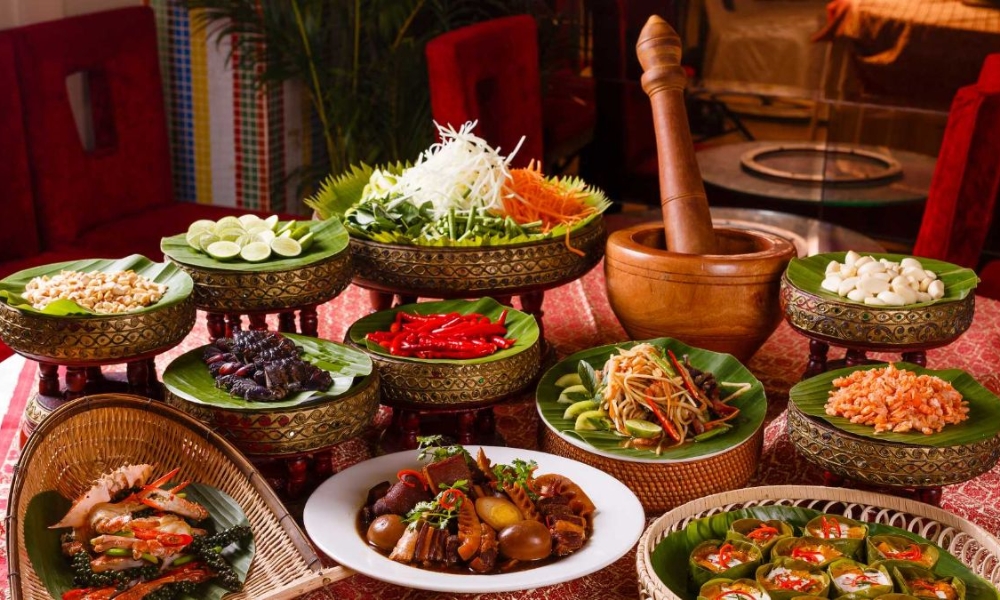Cambodia’s Lost Cuisine Makes a Powerful Return

Exploring Authentic Cambodian Dishes
Cambodian food, or Khmer cuisine, is rich in balance—sweet, salty, and sour, often in the same dish. Its subtle curries and fresh herbs create depth without overpowering spice. Yet, for decades, it slipped under the radar internationally. The reason wasn’t lack of flavor but history. The Khmer Rouge regime of the 1970s left deep scars, and among the many cultural losses was the country’s food heritage. Entire recipes vanished as restrictions on cooking and farming broke the chain of tradition.
Chefs Leading a Revival
In recent years, a new wave of chefs, most of them women, have made it their mission to revive Khmer recipes before they disappear completely. One of the most visible is Ros Rotanak, better known as Chef Nak. Her love of food began at Phnom Penh’s Doeurm Kor night market, where she helped her mother sell vegetables. Today, she’s one of Cambodia’s most recognizable culinary voices, teaching cooking classes and speaking passionately about the soul of Khmer flavors.
She often explains how Cambodians use tamarind in ways outsiders wouldn’t expect: young leaves and fruits in soups, dips, and stir-fry not just citrus or lime. For her, Khmer cuisine is a story of balance and ingenuity, rooted in everyday life.
From Market Notes to Award-Winning Books
A turning point came in 2010, when Nak visited the United States and saw Cambodian food mislabeled as Thai because diners didn’t recognize the cuisine. That sparked her mission to preserve it properly. She began traveling village to village across Cambodia, recording recipes from elders who had kept them alive through memory.
The result was Nhum in 2019, followed by Saoy in 2023, a cookbook that went on to be named Best of the Best in the World at the Gourmand Awards. Her work has turned oral traditions into written records, ensuring these flavors won’t vanish in a single generation.
Why Khmer Food Nearly Disappeared
The need for this revival becomes clear when you consider how the Khmer Rouge dismantled food culture. As historian Dr. Sambo Manara explains, cooking at home was banned, and those caught risked death. Families survived on thin porridge, and millions faced starvation. After the regime fell in 1979, younger generations turned toward fast food and foreign imports—pizza, burgers, and fried chicken—while traditional dishes and local crops declined. Many recipes faded as ingredients stopped being cultivated.
Recipes Brought Back to Life
Nak knew this trajectory had to change. She began filming elders preparing dishes like hmok soup, a less-famous cousin of fish amok, made with freshwater catfish simmered in lemongrass paste and coconut cream. Recording these dishes meant more than saving recipes—it was preserving memory.
Anthropologist Dr. Ang Chouan notes that, until the 1990s, Khmer restaurants were scarce even in Cambodia. Chinese-owned eateries dominated the food scene, while “refined” Khmer food rarely appeared on menus. Only recently has there been a push to spotlight Khmer cuisine as something worthy of pride, both locally and globally.

The Khmer Cuisine
Restaurants Shaping a New Era
Another pioneer is chef Kimsan Pol, co-head of Embassy Restaurant in Siem Reap and Sombok in Phnom Penh. Similar to Nak, she traversed Cambodia to gather recipes, but she also constructed restaurants with only female employees—areas that blend empowerment and hospitality. Her menus demonstrate how Khmer cuisine can change without losing its roots; they are contemporary yet firmly rooted in village customs.
Rediscovered Royal Recipes
Reclaiming recipes from the royal court, many of which were all but lost during the political unrest of the 1970s, is another aspect of reviving Khmer cuisine. Fortunately, Princess Rasmi Sobbhana Norodom’s cookbook, The Culinary Art of Cambodia, published in 1960, included information on about 170 dishes. One of these was samlor muktaa, also known as white pearl soup, which is unique in that it uses tapioca pearls in a flavorful broth that contains chicken, pork, prawns, and crab.
According to Nak, the dish is both unique and distinctly Cambodian, demonstrating the inventiveness that formerly characterized royal kitchens. She contributes to the reintroduction of these rediscovered recipes to audiences worldwide, in addition to Cambodians, by posting them online.
The Role of Food in Cultural Identity
For Nak, Pol, and others, this piece is about identity rather than just taste. Reclaiming history, mending cultural scars, and showcasing Cambodia’s bounty to the world are all made possible through food. It is as much a matter of pride as it is of preservation to share these dishes with visitors and diners from other countries.
In conclusion
Once on the verge of extinction, Cambodian cuisine is now reviving thanks to tenacious chefs who value recipes as cultural assets. Resilience is demonstrated on a plate when you eat a bowl of white pearl soup or sample an amok infused with lemongrass. In 2025, when authenticity and sustainability are more important than ever, Cambodia’s culinary renaissance offers more than just delicious food; it offers history, pride, and the taste of survival.



